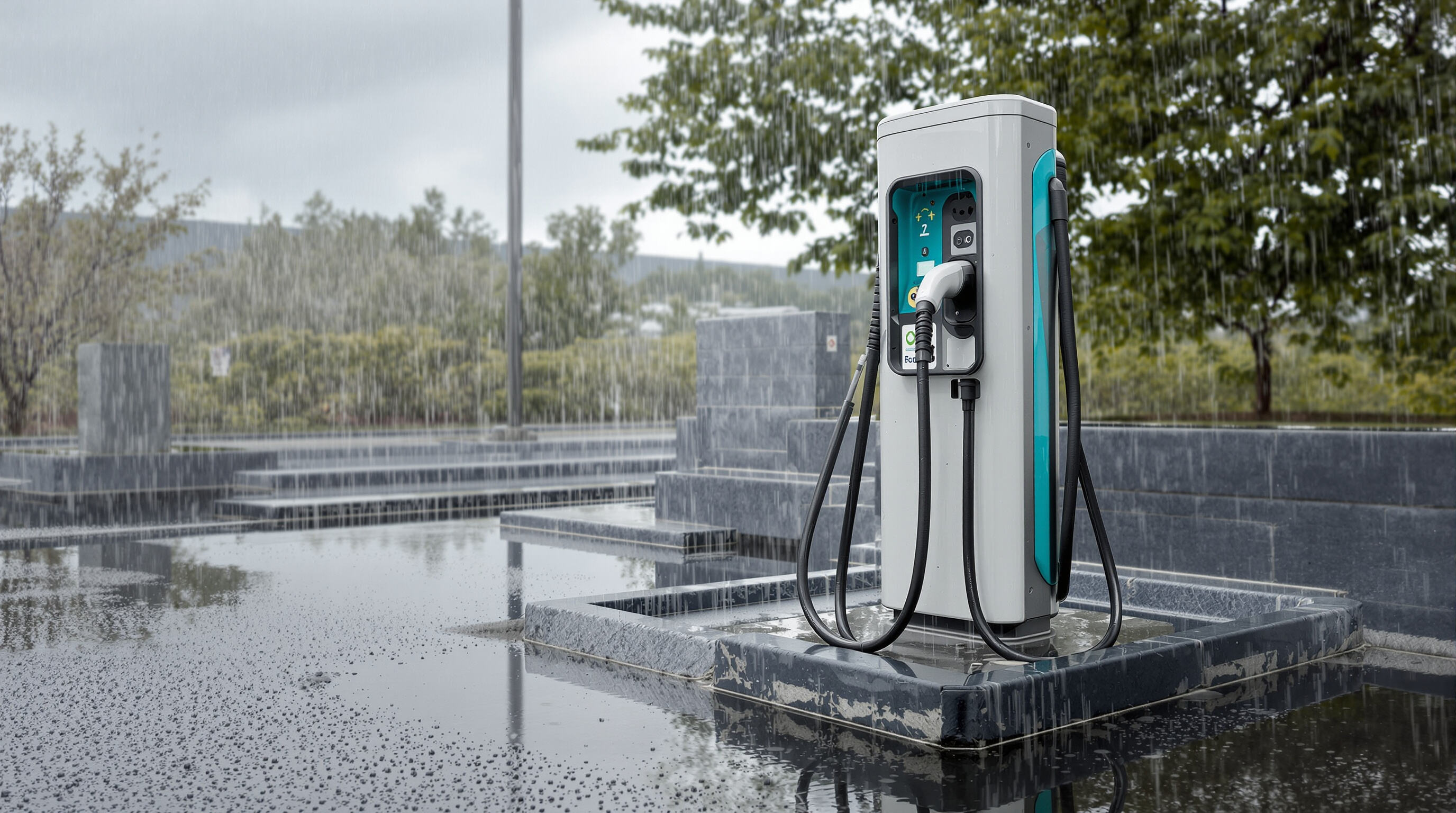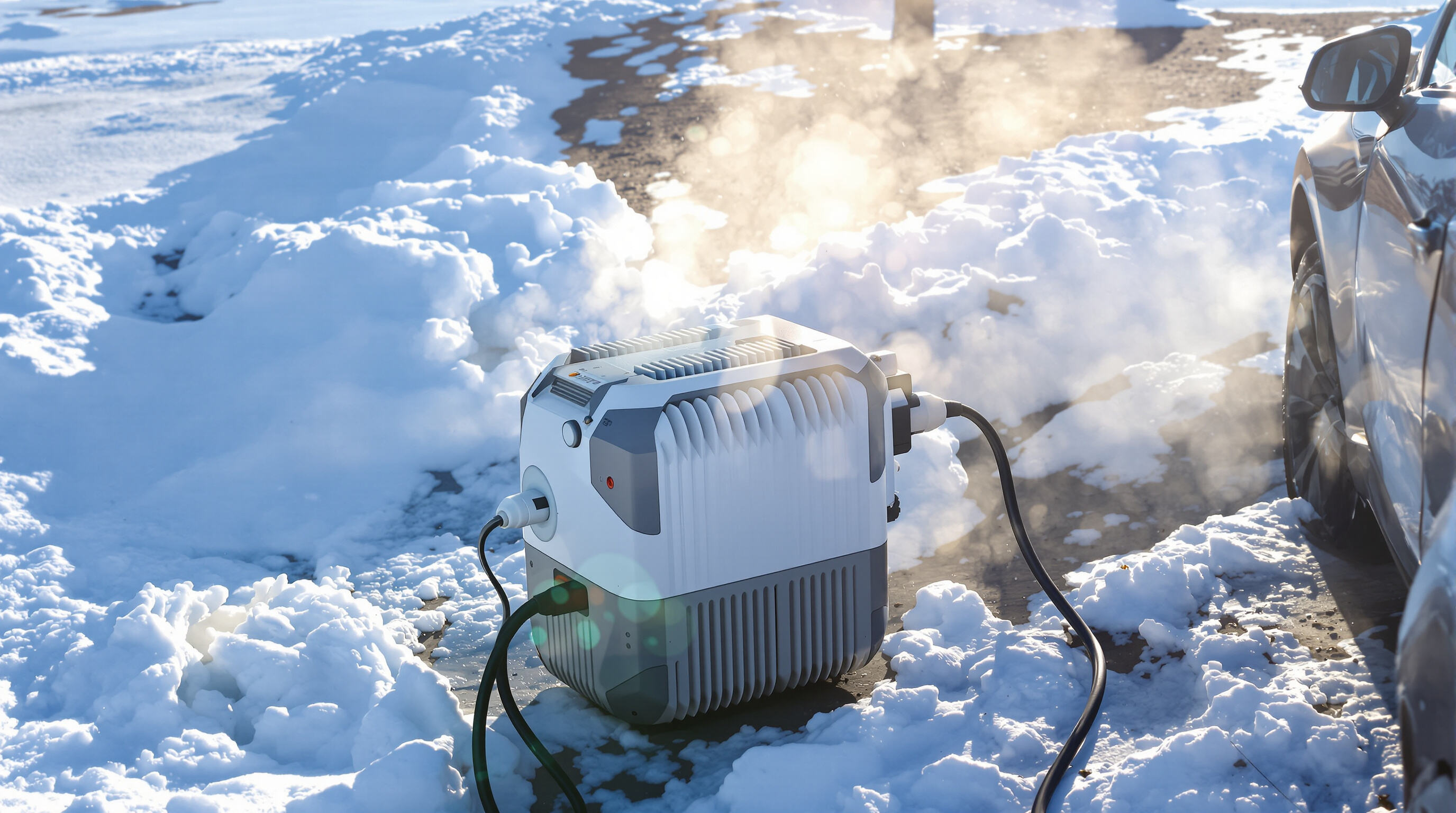IP66 Waterproof Rating: Why It's Essential for Outdoor Portable EV Chargers
What Does IP66 Mean for Ingress Protection in EVSE?
IP66 ratings matter a lot when it comes to Electric Vehicle Supply Equipment (EVSE). They basically mean these devices are completely protected from dust getting inside and can handle pretty strong water jets too. According to the international ingress protection standards, this kind of certification shows that portable EV chargers will keep working even when placed outside in tough conditions without risking any electrical problems. What does IP66 actually mean? Well, these units won't let dust in at all, and they can take on water jets shooting out around 100 liters every minute under about 100 kPa pressure. That's roughly what happens during heavy rain or when someone washes something with high pressure. So for people needing to charge their vehicles reliably no matter what the weather throws at them, IP66 rated equipment is definitely worth considering for those rough outdoor situations.
How IP66 Protects Against Dust and Water in Real-World Conditions
IP66-certified portable EV chargers are engineered to combat two major environmental threats:
- Dust resistance: Fully sealed enclosures prevent fine particulates like sand and dirt from entering sensitive circuitry, minimizing the risk of short circuits.
- Water resilience: Reinforced gaskets and strategically angled drainage paths shield internal components even during torrential downpours.
In real-world testing, IP66 chargers maintain operational integrity in 98% of wet-weather scenarios and outperform lower-rated models by 40% in dusty environments such as deserts or construction zones.
Comparing IP66 with IP54, IP65, and IP67: Which Is Best for Outdoor Use?
| IP Rating | Dust Protection | Water Resistance | Ideal Use Case |
|---|---|---|---|
| IP54 | Limited | Splash-proof | Indoor garages |
| IP65 | Dust-tight | Low-pressure jets | Sheltered outdoor areas |
| IP66 | Dust-tight | High-pressure jets | Coastal/off-road zones |
| IP67 | Dust-tight | Submersion (1m/30min) | Marine docks |
When looking at equipment for outdoor use, IP66 ratings generally strike a good middle ground between how tough they are and what they cost. These devices can handle rain pretty well and keep out dust too, which is great because getting something rated for full submersion (like IP67) would mean paying extra money and dealing with more complicated designs. Some research from last year showed interesting results too. They looked at how often different charging stations broke down near the coast and found that IP66 ones lasted twice as long as their IP65 counterparts. Over time, this actually saves businesses quite a bit of cash. We're talking around seven hundred forty thousand dollars saved by companies with large vehicle groups just within five years alone.
Field Performance of IP66-Rated Portable EV Chargers in Rain, Snow, and Coastal Climates
IP66-rated chargers excel in extreme environments:
- Rain: Operate reliably in downpours up to 15 mm/h across temperatures from -25°C to 50°C
- Snow: Resist freeze-thaw cycles without housing damage, meeting UL 2594 safety benchmarks
- Salt spray: Achieve 95% corrosion resistance after 1,000 hours of salt fog exposure
Data from mountain resorts and maritime operations show these chargers achieve 99.2% annual uptime-35% higher than non-certified alternatives-thanks to dual-layer silicone seals and military-grade thermoplastics.
Environmental Challenges: How Weather Impacts Portable EV Charger Reliability

Effects of Rain and Moisture on Charging Safety and Efficiency
Water getting into charging stations can really mess things up for the equipment, often leading to problems with insulation and dangerous ground faults. When we look at places where humidity is consistently high, those units without proper protection actually see about a 4.7 percent jump in electrical failures because of corrosion on contacts and moisture building up inside. Manufacturers have started using better sealing techniques and materials that repel water these days. Still, if a charger isn't rated IP66 or higher, heavy rain can slow down charging speeds by as much as 18 percent over time. That kind of performance drop matters a lot for operators who need reliable service even in bad weather conditions.
Operating in Snow and Freezing Temperatures: Risks and Limitations
When it gets really cold out there, both the charger itself and how batteries work get affected. Lithium ion batteries start working differently when temps drop to around minus 30 degrees Celsius, which is about minus 22 Fahrenheit. They actually use some power just to warm themselves up, making the whole charging process about 35 to maybe even 40 percent less efficient than normal. Connectors tend to ice over too, which messes with their ability to conduct electricity properly. And every time things freeze and then melt again, those little seals around the housing slowly break down. Some high end chargers try to fix this problem with special heated grips and clever software that adapts to cold conditions. But let's face it, most regular consumer models won't work well once temperatures go below roughly minus 10 degrees Celsius, which is about 14 degrees Fahrenheit on the Fahrenheit scale.
High Humidity and Condensation: Hidden Threats to Electrical Components
In tropical and coastal regions, persistent humidity and salt-laden air accelerate component degradation. Unprotected control boards can develop corrosion hotspots within 90 days under 80%+ relative humidity. Advanced chargers counteract this with conformal-coated electronics and breathable membrane vents that release moisture while maintaining dust protection.
Thermal Management and Operating Temperature Limits in Portable EV Charging

How Extreme Heat and Cold Affect Charger and Battery Performance
Portable electric vehicle chargers designed for outdoor use need to handle pretty extreme temperatures ranging from as cold as minus 30 degrees Celsius or around negative 22 Fahrenheit all the way up to 50 degrees Celsius which is roughly 122 Fahrenheit on the Fahrenheit scale. Most lithium ion batteries work best when they're somewhere between 20 and 25 degrees Celsius, that's about 68 to 77 degrees Fahrenheit for those who still think in Fahrenheit. When it gets really hot out there, something happens inside these batteries called increased internal resistance, and this can actually cut down how efficiently they charge by anywhere from 15 to 20 percent according to recent studies. On the flip side, if we get into freezing conditions below zero, battery capacity drops temporarily by nearly 30 percent as noted in EnrgTech research from 2024. The constant exposure to these temperature extremes does more than just make charging take longer. It speeds up wear and tear on the battery cells over time, so equipment might last anywhere from two to three years less outdoors compared with what would happen if kept indoors where temperature fluctuations aren't so severe.
Cooling and Heat Dissipation Design in Modern Outdoor-Grade EVSE
To manage thermal loads, advanced chargers employ:
- Aluminum alloy housings with integrated heat sinks
- Smart fans that activate at 40°C (104°F)
- Phase-change materials that absorb excess heat during fast charging
A 2024 thermal management study found that combining passive cooling with adaptive power modulation reduces peak operating temperatures by 28% during 240V charging. This approach prevents overheating while preserving charging speed—essential for users in hot climates requiring rapid top-ups.
Safe Operating Temperature Ranges for Reliable Outdoor Charging
Real world testing shows around one in four portable electric vehicle chargers stop working properly when temperatures drop below freezing point minus ten degrees Celsius (which is about 14 degrees Fahrenheit). That's why most manufacturers have started putting clear temperature warnings right on their products these days. The best quality units generally work fine between minus twenty degrees Celsius and fifty five degrees Celsius (-4 to 131 Fahrenheit), but they tend to slow down quite a bit at both ends of that range, cutting charging speeds by anywhere from quarter to half depending on conditions. Most industry experts actually advise against using DC fast charging systems when temps go over forty five degrees Celsius (roughly 113 Fahrenheit) since this can really mess up batteries permanently. Nearly nine out of ten new models released in 2024 come equipped with built in temperature monitoring that will simply shut off the charging process whenever things get too hot inside the unit.
Safety and Compliance: Ensuring Secure Outdoor Use of Portable EV Chargers
Mitigating Electrical Hazards from Moisture and Environmental Exposure
Seals rated IP66 along with composite materials that resist corrosion work together to stop ions from getting into terminal connections, which keeps electrical systems properly isolated. When it comes to water management, automatic drainage channels kick in almost instantly after contact, usually clearing standing water within around 15 seconds. Meanwhile, the reinforced dielectric barriers can handle over 1.5 kilovolts of isolation voltage even when things get damp. That's actually 34 percent higher than what the IEC 61851-1 standard requires according to recent findings by the EV Safety Institute back in 2024. All these design elements make a big difference for safety during harsh weather conditions like heavy rain or snowstorms where regular equipment might fail.
Ground Fault Protection and Insulation Standards in Outdoor EVSE Design
The latest portable EV chargers come equipped with ground fault detection that reacts to just 5 milliampere leaks, which means their breakers trip about 30 percent quicker than what the National Electrical Code requires for 2023. The cables have two layers of insulation that can handle an impressive 16 kilovolts per millimeter when subjected to salt fog tests something really important if someone plans on charging near coastal areas or anywhere with high humidity. Independent testing labs have looked into this stuff too, and they found that these safety features cut down problems with outdoor charging by almost 80% when compared against cheaper, non-certified models out there on the market today.
Balancing Portability with Safety: The Industry Challenge for Durable EV Chargers
Some of the newer designs incorporate magnesium alloy casings similar to what's used in aircraft manufacturing. These cases only tip the scales at around 2.1 kilograms but still manage to meet IK10 standards for impact resistance. Products certified under UL 2594 show impressive results too they maintain 98 percent protection against moisture even after going through 500 freeze thaw cycles. This basically solves the old problem where something either had to be lightweight or tough, but not both. The downside though is that these top tier models tend to take up about 23 percent more space on a desk compared to regular indoor versions. Makes sense really because getting something durable enough for harsh conditions requires some extra room for all those protective features.
Frequently Asked Questions
What does IP66 mean for outdoor EV chargers?
The IP66 rating indicates that a charger is completely dust-tight and can withstand powerful water jets, making it reliable for outdoor use in various weather conditions.
How does IP66 compare to other ratings like IP54, IP65, and IP67?
IP66 offers superior dust and water protection compared to IP54 and IP65, making it more suitable for coastal and off-road areas, whereas IP67 is designed for equipment that might face submersion.
Will an IP66 charger work in extreme temperatures?
Yes, IP66 chargers are designed to handle a wide range of temperatures, from extremely cold conditions to high heat, making them suitable for various climates.
How do IP66-rated chargers withstand high humidity and moisture?
IP66 chargers are built with conformal-coated electronics and drainage systems that manage moisture, preventing corrosion and preserving functionality in humid environments.
Table of Contents
- IP66 Waterproof Rating: Why It's Essential for Outdoor Portable EV Chargers
- Environmental Challenges: How Weather Impacts Portable EV Charger Reliability
- Thermal Management and Operating Temperature Limits in Portable EV Charging
- Safety and Compliance: Ensuring Secure Outdoor Use of Portable EV Chargers
- Frequently Asked Questions

